BTEC Unit 12: Organisational Culture and Workforce Motivation Report
VerifiedAdded on 2022/11/29
|14
|4440
|283
Report
AI Summary
This report provides a comprehensive analysis of organisational culture and workforce motivation, focusing on how culture, politics, and power influence individual and team behavior and performance within an organisation, using Apple as a case study. The report explores Handy's culture model, organizational politics, and the French and Raven power model, and their effects on individuals and teams. It then delves into the impact of motivation on performance, examining both content theories, such as Maslow's hierarchy of needs, and process theories, such as Vroom's expectancy theory. Furthermore, the report identifies factors that differentiate effective and ineffective teams and discusses relevant group development theories. Finally, the report applies concepts and philosophies of organisational behaviour within a given business situation, highlighting the importance of managing culture, power, and politics to create a positive working environment. The report concludes by emphasizing the importance of employee motivation, respect, and growth opportunities for organisational success.
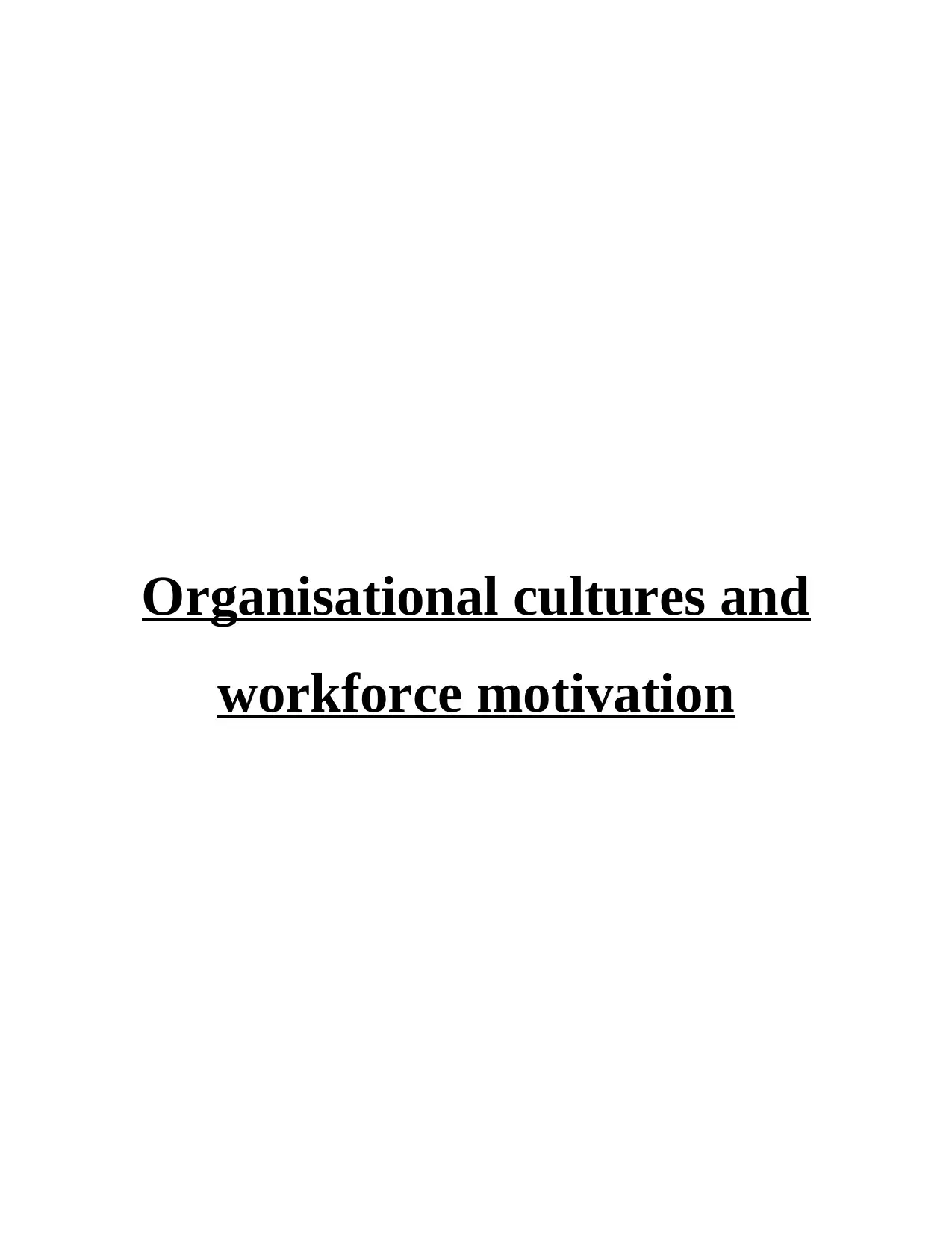
Organisational cultures and
workforce motivation
workforce motivation
Paraphrase This Document
Need a fresh take? Get an instant paraphrase of this document with our AI Paraphraser
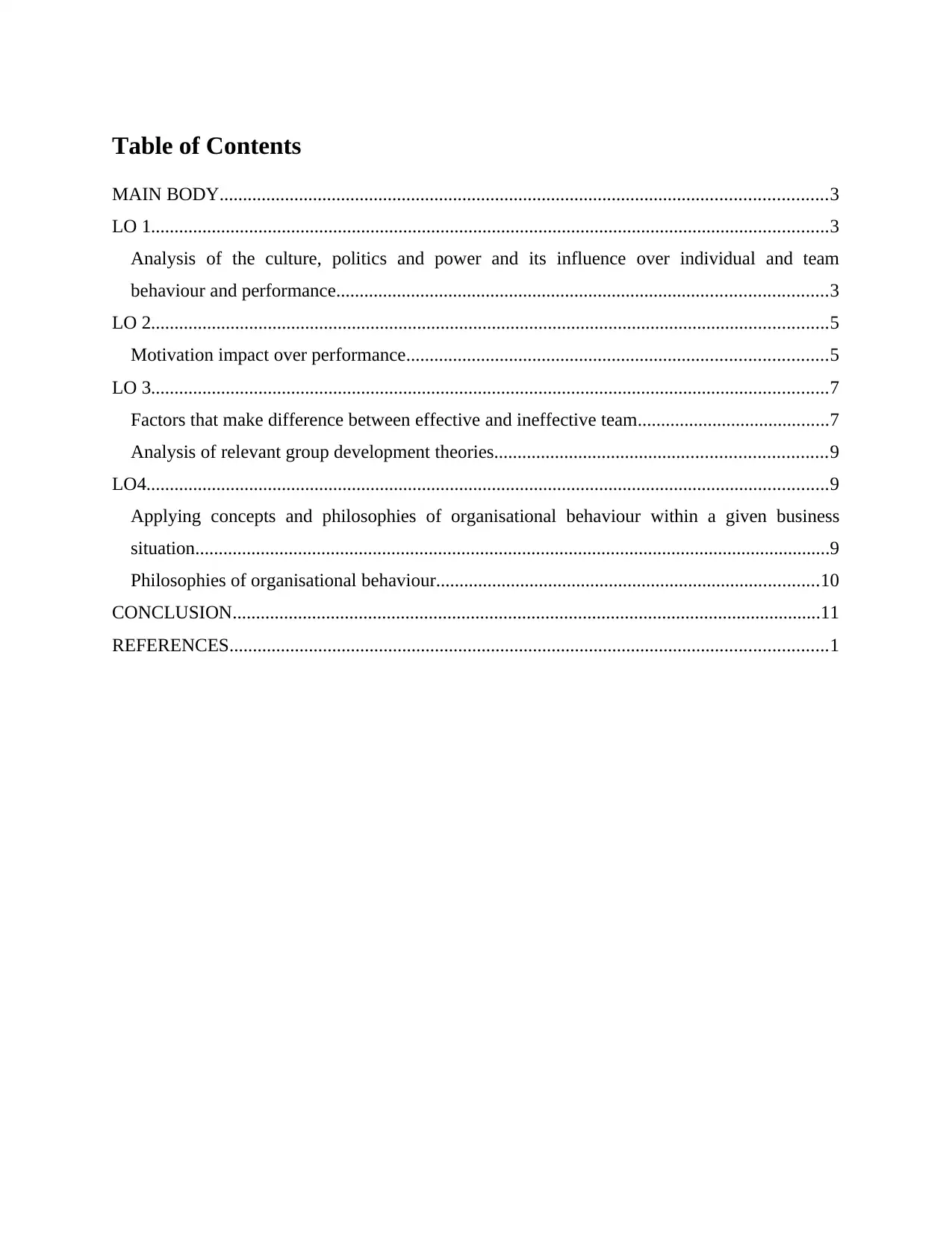
Table of Contents
MAIN BODY..................................................................................................................................3
LO 1.................................................................................................................................................3
Analysis of the culture, politics and power and its influence over individual and team
behaviour and performance.........................................................................................................3
LO 2.................................................................................................................................................5
Motivation impact over performance..........................................................................................5
LO 3.................................................................................................................................................7
Factors that make difference between effective and ineffective team.........................................7
Analysis of relevant group development theories.......................................................................9
LO4..................................................................................................................................................9
Applying concepts and philosophies of organisational behaviour within a given business
situation........................................................................................................................................9
Philosophies of organisational behaviour..................................................................................10
CONCLUSION..............................................................................................................................11
REFERENCES................................................................................................................................1
MAIN BODY..................................................................................................................................3
LO 1.................................................................................................................................................3
Analysis of the culture, politics and power and its influence over individual and team
behaviour and performance.........................................................................................................3
LO 2.................................................................................................................................................5
Motivation impact over performance..........................................................................................5
LO 3.................................................................................................................................................7
Factors that make difference between effective and ineffective team.........................................7
Analysis of relevant group development theories.......................................................................9
LO4..................................................................................................................................................9
Applying concepts and philosophies of organisational behaviour within a given business
situation........................................................................................................................................9
Philosophies of organisational behaviour..................................................................................10
CONCLUSION..............................................................................................................................11
REFERENCES................................................................................................................................1
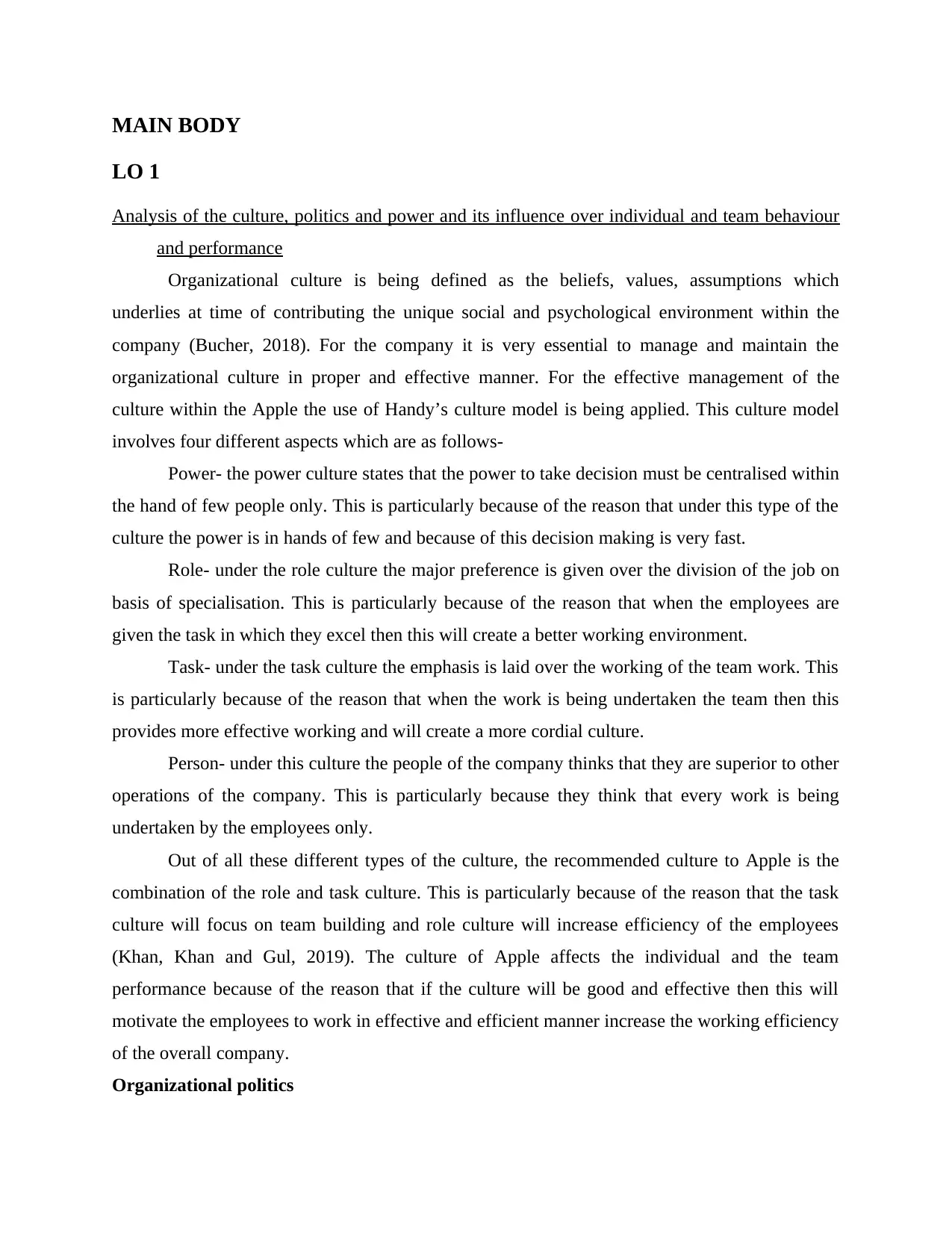
MAIN BODY
LO 1
Analysis of the culture, politics and power and its influence over individual and team behaviour
and performance
Organizational culture is being defined as the beliefs, values, assumptions which
underlies at time of contributing the unique social and psychological environment within the
company (Bucher, 2018). For the company it is very essential to manage and maintain the
organizational culture in proper and effective manner. For the effective management of the
culture within the Apple the use of Handy’s culture model is being applied. This culture model
involves four different aspects which are as follows-
Power- the power culture states that the power to take decision must be centralised within
the hand of few people only. This is particularly because of the reason that under this type of the
culture the power is in hands of few and because of this decision making is very fast.
Role- under the role culture the major preference is given over the division of the job on
basis of specialisation. This is particularly because of the reason that when the employees are
given the task in which they excel then this will create a better working environment.
Task- under the task culture the emphasis is laid over the working of the team work. This
is particularly because of the reason that when the work is being undertaken the team then this
provides more effective working and will create a more cordial culture.
Person- under this culture the people of the company thinks that they are superior to other
operations of the company. This is particularly because they think that every work is being
undertaken by the employees only.
Out of all these different types of the culture, the recommended culture to Apple is the
combination of the role and task culture. This is particularly because of the reason that the task
culture will focus on team building and role culture will increase efficiency of the employees
(Khan, Khan and Gul, 2019). The culture of Apple affects the individual and the team
performance because of the reason that if the culture will be good and effective then this will
motivate the employees to work in effective and efficient manner increase the working efficiency
of the overall company.
Organizational politics
LO 1
Analysis of the culture, politics and power and its influence over individual and team behaviour
and performance
Organizational culture is being defined as the beliefs, values, assumptions which
underlies at time of contributing the unique social and psychological environment within the
company (Bucher, 2018). For the company it is very essential to manage and maintain the
organizational culture in proper and effective manner. For the effective management of the
culture within the Apple the use of Handy’s culture model is being applied. This culture model
involves four different aspects which are as follows-
Power- the power culture states that the power to take decision must be centralised within
the hand of few people only. This is particularly because of the reason that under this type of the
culture the power is in hands of few and because of this decision making is very fast.
Role- under the role culture the major preference is given over the division of the job on
basis of specialisation. This is particularly because of the reason that when the employees are
given the task in which they excel then this will create a better working environment.
Task- under the task culture the emphasis is laid over the working of the team work. This
is particularly because of the reason that when the work is being undertaken the team then this
provides more effective working and will create a more cordial culture.
Person- under this culture the people of the company thinks that they are superior to other
operations of the company. This is particularly because they think that every work is being
undertaken by the employees only.
Out of all these different types of the culture, the recommended culture to Apple is the
combination of the role and task culture. This is particularly because of the reason that the task
culture will focus on team building and role culture will increase efficiency of the employees
(Khan, Khan and Gul, 2019). The culture of Apple affects the individual and the team
performance because of the reason that if the culture will be good and effective then this will
motivate the employees to work in effective and efficient manner increase the working efficiency
of the overall company.
Organizational politics
⊘ This is a preview!⊘
Do you want full access?
Subscribe today to unlock all pages.

Trusted by 1+ million students worldwide
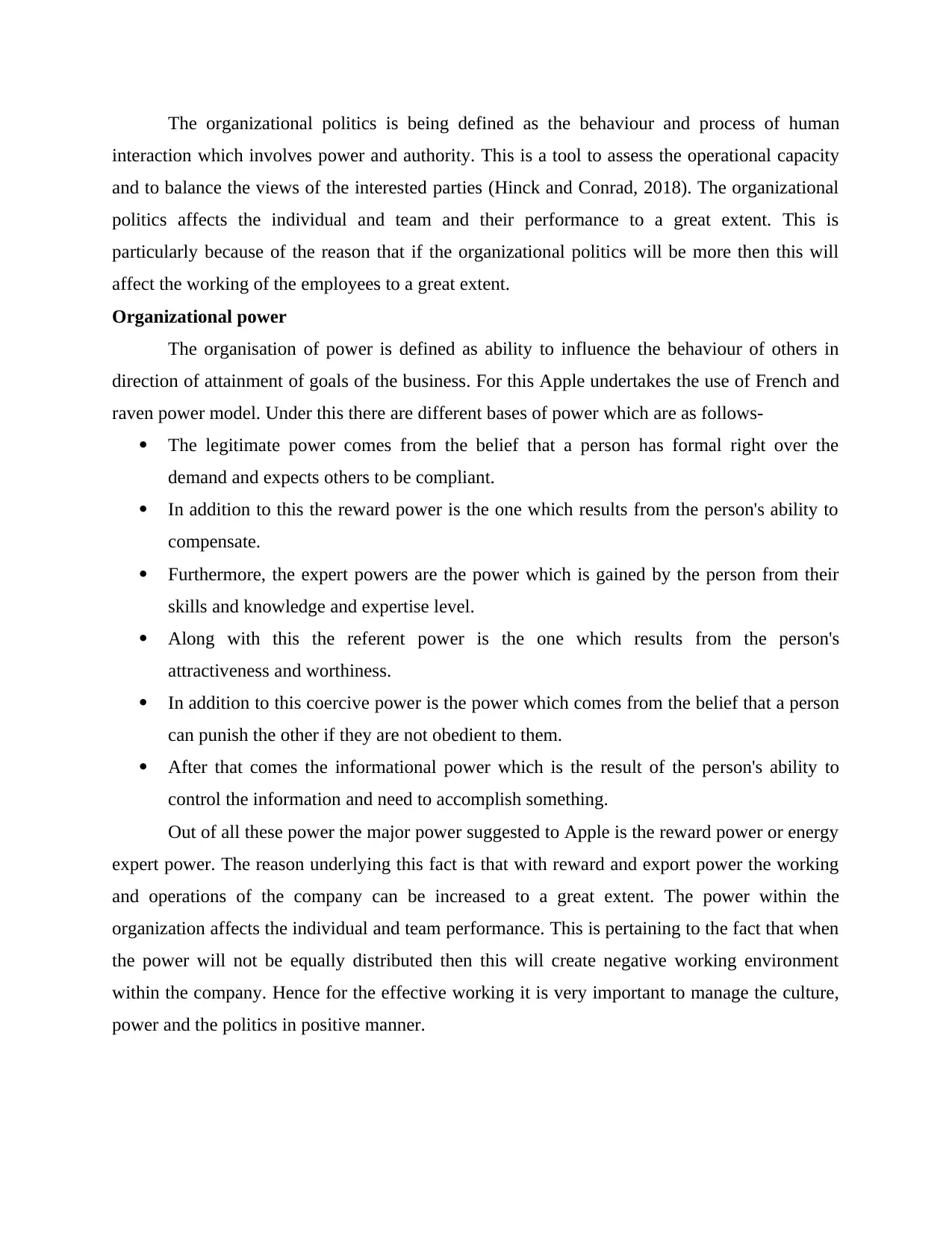
The organizational politics is being defined as the behaviour and process of human
interaction which involves power and authority. This is a tool to assess the operational capacity
and to balance the views of the interested parties (Hinck and Conrad, 2018). The organizational
politics affects the individual and team and their performance to a great extent. This is
particularly because of the reason that if the organizational politics will be more then this will
affect the working of the employees to a great extent.
Organizational power
The organisation of power is defined as ability to influence the behaviour of others in
direction of attainment of goals of the business. For this Apple undertakes the use of French and
raven power model. Under this there are different bases of power which are as follows-
The legitimate power comes from the belief that a person has formal right over the
demand and expects others to be compliant.
In addition to this the reward power is the one which results from the person's ability to
compensate.
Furthermore, the expert powers are the power which is gained by the person from their
skills and knowledge and expertise level.
Along with this the referent power is the one which results from the person's
attractiveness and worthiness.
In addition to this coercive power is the power which comes from the belief that a person
can punish the other if they are not obedient to them.
After that comes the informational power which is the result of the person's ability to
control the information and need to accomplish something.
Out of all these power the major power suggested to Apple is the reward power or energy
expert power. The reason underlying this fact is that with reward and export power the working
and operations of the company can be increased to a great extent. The power within the
organization affects the individual and team performance. This is pertaining to the fact that when
the power will not be equally distributed then this will create negative working environment
within the company. Hence for the effective working it is very important to manage the culture,
power and the politics in positive manner.
interaction which involves power and authority. This is a tool to assess the operational capacity
and to balance the views of the interested parties (Hinck and Conrad, 2018). The organizational
politics affects the individual and team and their performance to a great extent. This is
particularly because of the reason that if the organizational politics will be more then this will
affect the working of the employees to a great extent.
Organizational power
The organisation of power is defined as ability to influence the behaviour of others in
direction of attainment of goals of the business. For this Apple undertakes the use of French and
raven power model. Under this there are different bases of power which are as follows-
The legitimate power comes from the belief that a person has formal right over the
demand and expects others to be compliant.
In addition to this the reward power is the one which results from the person's ability to
compensate.
Furthermore, the expert powers are the power which is gained by the person from their
skills and knowledge and expertise level.
Along with this the referent power is the one which results from the person's
attractiveness and worthiness.
In addition to this coercive power is the power which comes from the belief that a person
can punish the other if they are not obedient to them.
After that comes the informational power which is the result of the person's ability to
control the information and need to accomplish something.
Out of all these power the major power suggested to Apple is the reward power or energy
expert power. The reason underlying this fact is that with reward and export power the working
and operations of the company can be increased to a great extent. The power within the
organization affects the individual and team performance. This is pertaining to the fact that when
the power will not be equally distributed then this will create negative working environment
within the company. Hence for the effective working it is very important to manage the culture,
power and the politics in positive manner.
Paraphrase This Document
Need a fresh take? Get an instant paraphrase of this document with our AI Paraphraser
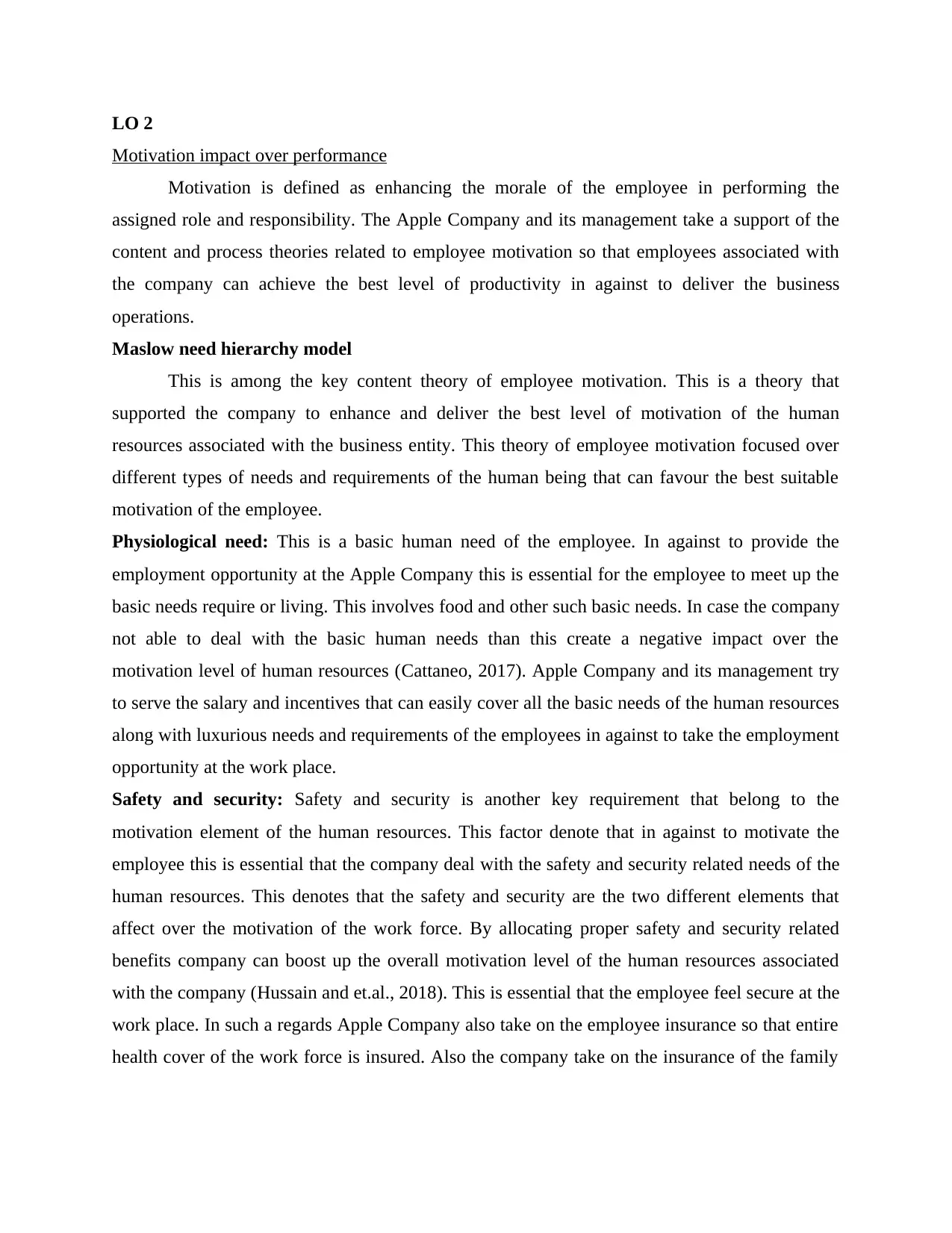
LO 2
Motivation impact over performance
Motivation is defined as enhancing the morale of the employee in performing the
assigned role and responsibility. The Apple Company and its management take a support of the
content and process theories related to employee motivation so that employees associated with
the company can achieve the best level of productivity in against to deliver the business
operations.
Maslow need hierarchy model
This is among the key content theory of employee motivation. This is a theory that
supported the company to enhance and deliver the best level of motivation of the human
resources associated with the business entity. This theory of employee motivation focused over
different types of needs and requirements of the human being that can favour the best suitable
motivation of the employee.
Physiological need: This is a basic human need of the employee. In against to provide the
employment opportunity at the Apple Company this is essential for the employee to meet up the
basic needs require or living. This involves food and other such basic needs. In case the company
not able to deal with the basic human needs than this create a negative impact over the
motivation level of human resources (Cattaneo, 2017). Apple Company and its management try
to serve the salary and incentives that can easily cover all the basic needs of the human resources
along with luxurious needs and requirements of the employees in against to take the employment
opportunity at the work place.
Safety and security: Safety and security is another key requirement that belong to the
motivation element of the human resources. This factor denote that in against to motivate the
employee this is essential that the company deal with the safety and security related needs of the
human resources. This denotes that the safety and security are the two different elements that
affect over the motivation of the work force. By allocating proper safety and security related
benefits company can boost up the overall motivation level of the human resources associated
with the company (Hussain and et.al., 2018). This is essential that the employee feel secure at the
work place. In such a regards Apple Company also take on the employee insurance so that entire
health cover of the work force is insured. Also the company take on the insurance of the family
Motivation impact over performance
Motivation is defined as enhancing the morale of the employee in performing the
assigned role and responsibility. The Apple Company and its management take a support of the
content and process theories related to employee motivation so that employees associated with
the company can achieve the best level of productivity in against to deliver the business
operations.
Maslow need hierarchy model
This is among the key content theory of employee motivation. This is a theory that
supported the company to enhance and deliver the best level of motivation of the human
resources associated with the business entity. This theory of employee motivation focused over
different types of needs and requirements of the human being that can favour the best suitable
motivation of the employee.
Physiological need: This is a basic human need of the employee. In against to provide the
employment opportunity at the Apple Company this is essential for the employee to meet up the
basic needs require or living. This involves food and other such basic needs. In case the company
not able to deal with the basic human needs than this create a negative impact over the
motivation level of human resources (Cattaneo, 2017). Apple Company and its management try
to serve the salary and incentives that can easily cover all the basic needs of the human resources
along with luxurious needs and requirements of the employees in against to take the employment
opportunity at the work place.
Safety and security: Safety and security is another key requirement that belong to the
motivation element of the human resources. This factor denote that in against to motivate the
employee this is essential that the company deal with the safety and security related needs of the
human resources. This denotes that the safety and security are the two different elements that
affect over the motivation of the work force. By allocating proper safety and security related
benefits company can boost up the overall motivation level of the human resources associated
with the company (Hussain and et.al., 2018). This is essential that the employee feel secure at the
work place. In such a regards Apple Company also take on the employee insurance so that entire
health cover of the work force is insured. Also the company take on the insurance of the family
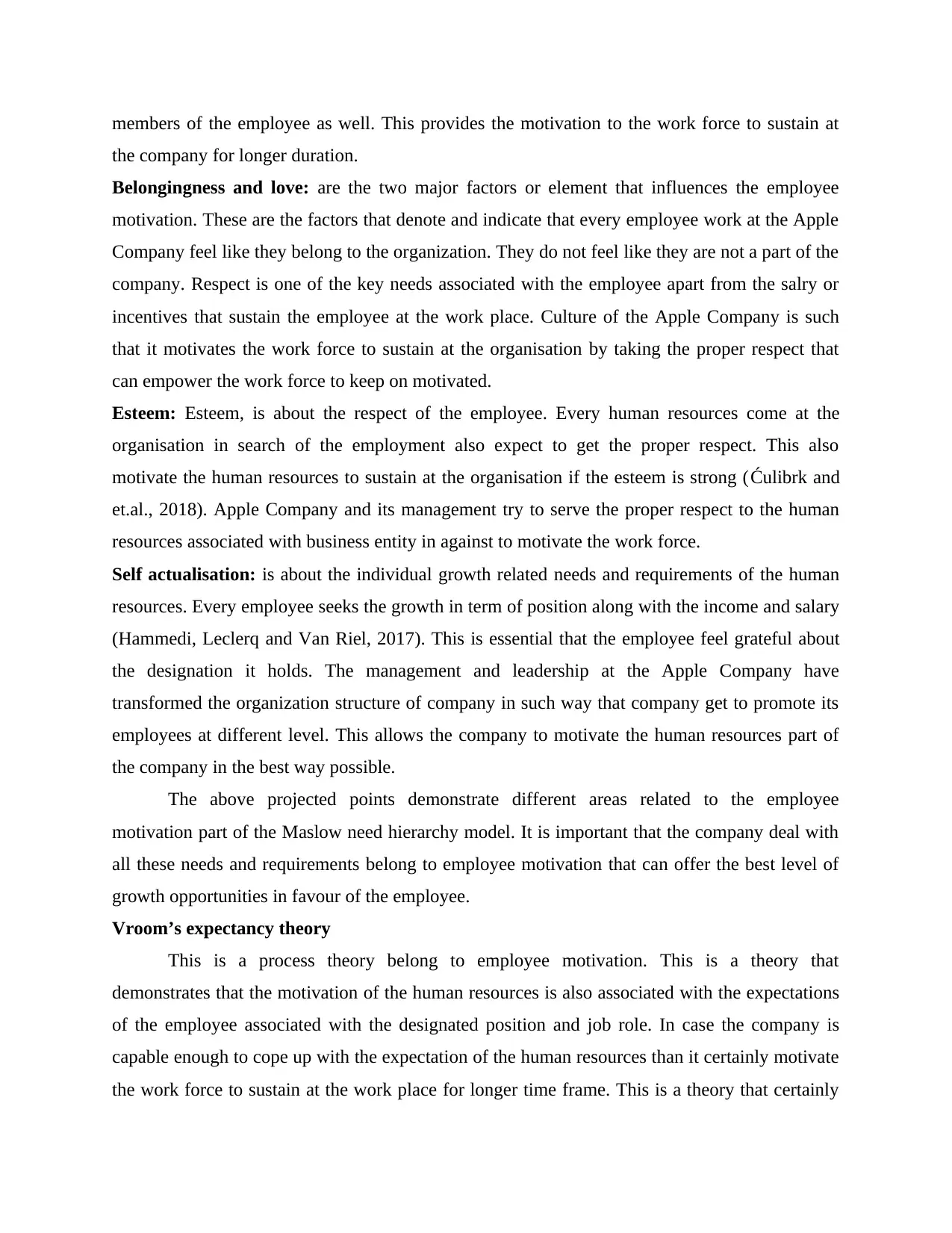
members of the employee as well. This provides the motivation to the work force to sustain at
the company for longer duration.
Belongingness and love: are the two major factors or element that influences the employee
motivation. These are the factors that denote and indicate that every employee work at the Apple
Company feel like they belong to the organization. They do not feel like they are not a part of the
company. Respect is one of the key needs associated with the employee apart from the salry or
incentives that sustain the employee at the work place. Culture of the Apple Company is such
that it motivates the work force to sustain at the organisation by taking the proper respect that
can empower the work force to keep on motivated.
Esteem: Esteem, is about the respect of the employee. Every human resources come at the
organisation in search of the employment also expect to get the proper respect. This also
motivate the human resources to sustain at the organisation if the esteem is strong (Ćulibrk and
et.al., 2018). Apple Company and its management try to serve the proper respect to the human
resources associated with business entity in against to motivate the work force.
Self actualisation: is about the individual growth related needs and requirements of the human
resources. Every employee seeks the growth in term of position along with the income and salary
(Hammedi, Leclerq and Van Riel, 2017). This is essential that the employee feel grateful about
the designation it holds. The management and leadership at the Apple Company have
transformed the organization structure of company in such way that company get to promote its
employees at different level. This allows the company to motivate the human resources part of
the company in the best way possible.
The above projected points demonstrate different areas related to the employee
motivation part of the Maslow need hierarchy model. It is important that the company deal with
all these needs and requirements belong to employee motivation that can offer the best level of
growth opportunities in favour of the employee.
Vroom’s expectancy theory
This is a process theory belong to employee motivation. This is a theory that
demonstrates that the motivation of the human resources is also associated with the expectations
of the employee associated with the designated position and job role. In case the company is
capable enough to cope up with the expectation of the human resources than it certainly motivate
the work force to sustain at the work place for longer time frame. This is a theory that certainly
the company for longer duration.
Belongingness and love: are the two major factors or element that influences the employee
motivation. These are the factors that denote and indicate that every employee work at the Apple
Company feel like they belong to the organization. They do not feel like they are not a part of the
company. Respect is one of the key needs associated with the employee apart from the salry or
incentives that sustain the employee at the work place. Culture of the Apple Company is such
that it motivates the work force to sustain at the organisation by taking the proper respect that
can empower the work force to keep on motivated.
Esteem: Esteem, is about the respect of the employee. Every human resources come at the
organisation in search of the employment also expect to get the proper respect. This also
motivate the human resources to sustain at the organisation if the esteem is strong (Ćulibrk and
et.al., 2018). Apple Company and its management try to serve the proper respect to the human
resources associated with business entity in against to motivate the work force.
Self actualisation: is about the individual growth related needs and requirements of the human
resources. Every employee seeks the growth in term of position along with the income and salary
(Hammedi, Leclerq and Van Riel, 2017). This is essential that the employee feel grateful about
the designation it holds. The management and leadership at the Apple Company have
transformed the organization structure of company in such way that company get to promote its
employees at different level. This allows the company to motivate the human resources part of
the company in the best way possible.
The above projected points demonstrate different areas related to the employee
motivation part of the Maslow need hierarchy model. It is important that the company deal with
all these needs and requirements belong to employee motivation that can offer the best level of
growth opportunities in favour of the employee.
Vroom’s expectancy theory
This is a process theory belong to employee motivation. This is a theory that
demonstrates that the motivation of the human resources is also associated with the expectations
of the employee associated with the designated position and job role. In case the company is
capable enough to cope up with the expectation of the human resources than it certainly motivate
the work force to sustain at the work place for longer time frame. This is a theory that certainly
⊘ This is a preview!⊘
Do you want full access?
Subscribe today to unlock all pages.

Trusted by 1+ million students worldwide
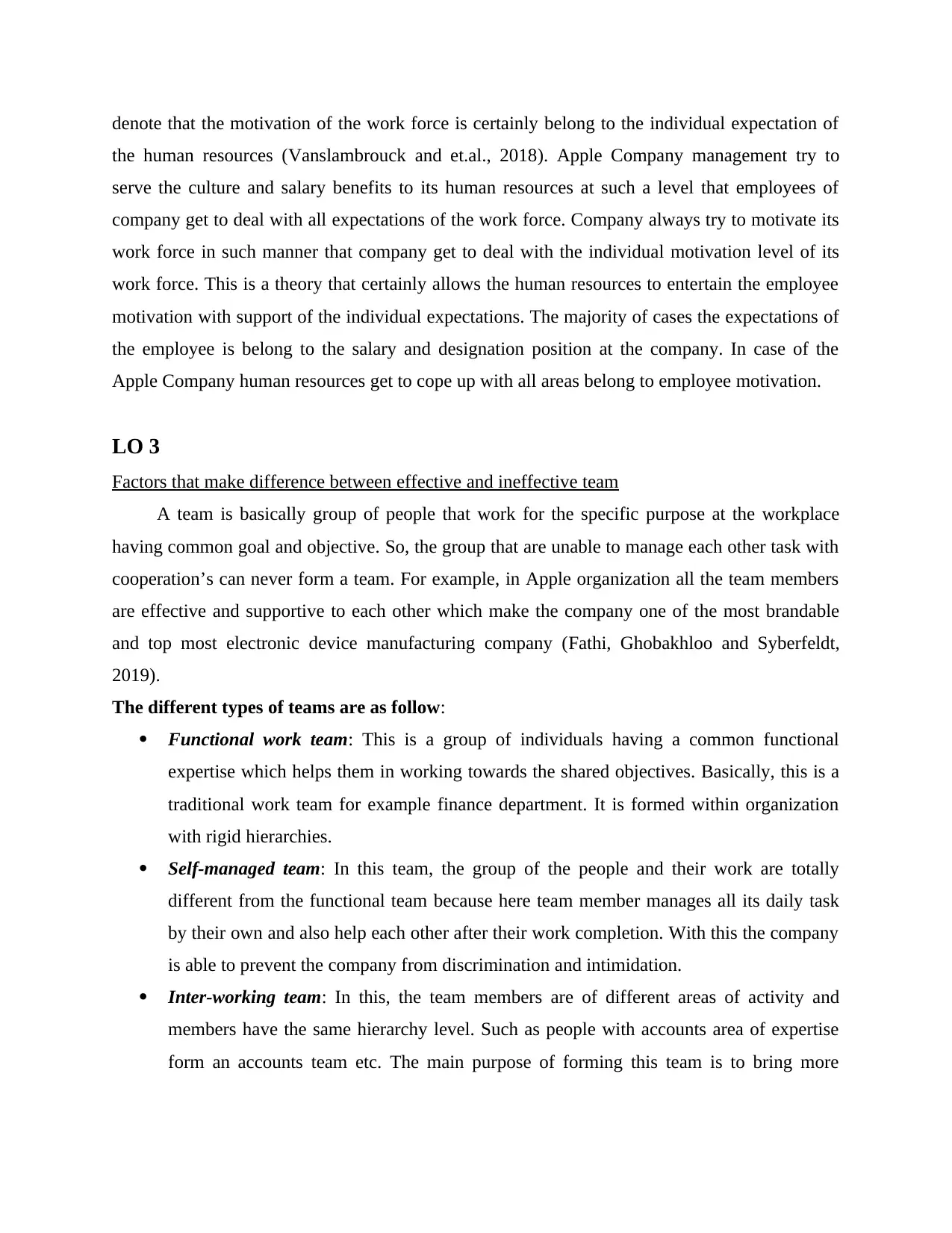
denote that the motivation of the work force is certainly belong to the individual expectation of
the human resources (Vanslambrouck and et.al., 2018). Apple Company management try to
serve the culture and salary benefits to its human resources at such a level that employees of
company get to deal with all expectations of the work force. Company always try to motivate its
work force in such manner that company get to deal with the individual motivation level of its
work force. This is a theory that certainly allows the human resources to entertain the employee
motivation with support of the individual expectations. The majority of cases the expectations of
the employee is belong to the salary and designation position at the company. In case of the
Apple Company human resources get to cope up with all areas belong to employee motivation.
LO 3
Factors that make difference between effective and ineffective team
A team is basically group of people that work for the specific purpose at the workplace
having common goal and objective. So, the group that are unable to manage each other task with
cooperation’s can never form a team. For example, in Apple organization all the team members
are effective and supportive to each other which make the company one of the most brandable
and top most electronic device manufacturing company (Fathi, Ghobakhloo and Syberfeldt,
2019).
The different types of teams are as follow:
Functional work team: This is a group of individuals having a common functional
expertise which helps them in working towards the shared objectives. Basically, this is a
traditional work team for example finance department. It is formed within organization
with rigid hierarchies.
Self-managed team: In this team, the group of the people and their work are totally
different from the functional team because here team member manages all its daily task
by their own and also help each other after their work completion. With this the company
is able to prevent the company from discrimination and intimidation.
Inter-working team: In this, the team members are of different areas of activity and
members have the same hierarchy level. Such as people with accounts area of expertise
form an accounts team etc. The main purpose of forming this team is to bring more
the human resources (Vanslambrouck and et.al., 2018). Apple Company management try to
serve the culture and salary benefits to its human resources at such a level that employees of
company get to deal with all expectations of the work force. Company always try to motivate its
work force in such manner that company get to deal with the individual motivation level of its
work force. This is a theory that certainly allows the human resources to entertain the employee
motivation with support of the individual expectations. The majority of cases the expectations of
the employee is belong to the salary and designation position at the company. In case of the
Apple Company human resources get to cope up with all areas belong to employee motivation.
LO 3
Factors that make difference between effective and ineffective team
A team is basically group of people that work for the specific purpose at the workplace
having common goal and objective. So, the group that are unable to manage each other task with
cooperation’s can never form a team. For example, in Apple organization all the team members
are effective and supportive to each other which make the company one of the most brandable
and top most electronic device manufacturing company (Fathi, Ghobakhloo and Syberfeldt,
2019).
The different types of teams are as follow:
Functional work team: This is a group of individuals having a common functional
expertise which helps them in working towards the shared objectives. Basically, this is a
traditional work team for example finance department. It is formed within organization
with rigid hierarchies.
Self-managed team: In this team, the group of the people and their work are totally
different from the functional team because here team member manages all its daily task
by their own and also help each other after their work completion. With this the company
is able to prevent the company from discrimination and intimidation.
Inter-working team: In this, the team members are of different areas of activity and
members have the same hierarchy level. Such as people with accounts area of expertise
form an accounts team etc. The main purpose of forming this team is to bring more
Paraphrase This Document
Need a fresh take? Get an instant paraphrase of this document with our AI Paraphraser
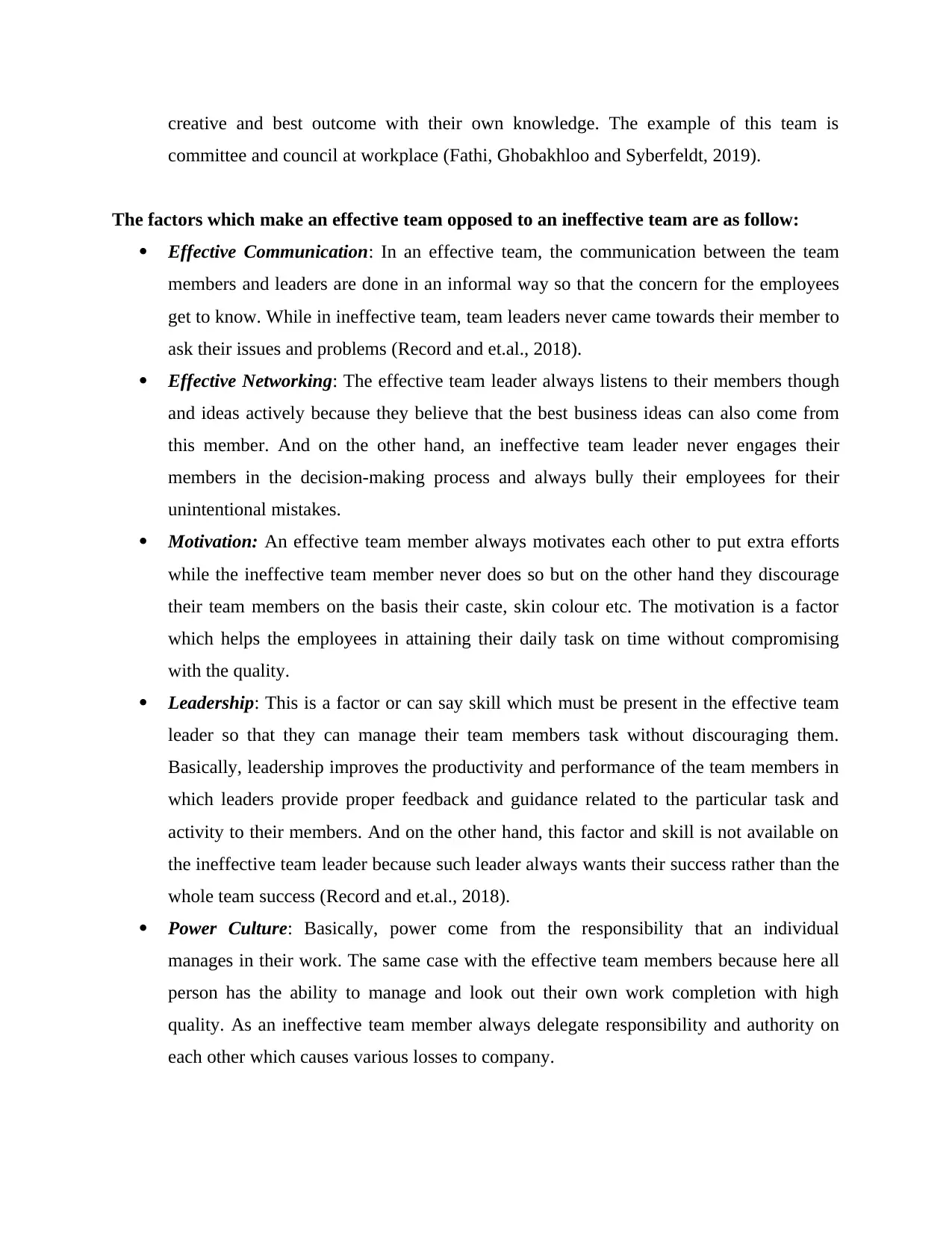
creative and best outcome with their own knowledge. The example of this team is
committee and council at workplace (Fathi, Ghobakhloo and Syberfeldt, 2019).
The factors which make an effective team opposed to an ineffective team are as follow:
Effective Communication: In an effective team, the communication between the team
members and leaders are done in an informal way so that the concern for the employees
get to know. While in ineffective team, team leaders never came towards their member to
ask their issues and problems (Record and et.al., 2018).
Effective Networking: The effective team leader always listens to their members though
and ideas actively because they believe that the best business ideas can also come from
this member. And on the other hand, an ineffective team leader never engages their
members in the decision-making process and always bully their employees for their
unintentional mistakes.
Motivation: An effective team member always motivates each other to put extra efforts
while the ineffective team member never does so but on the other hand they discourage
their team members on the basis their caste, skin colour etc. The motivation is a factor
which helps the employees in attaining their daily task on time without compromising
with the quality.
Leadership: This is a factor or can say skill which must be present in the effective team
leader so that they can manage their team members task without discouraging them.
Basically, leadership improves the productivity and performance of the team members in
which leaders provide proper feedback and guidance related to the particular task and
activity to their members. And on the other hand, this factor and skill is not available on
the ineffective team leader because such leader always wants their success rather than the
whole team success (Record and et.al., 2018).
Power Culture: Basically, power come from the responsibility that an individual
manages in their work. The same case with the effective team members because here all
person has the ability to manage and look out their own work completion with high
quality. As an ineffective team member always delegate responsibility and authority on
each other which causes various losses to company.
committee and council at workplace (Fathi, Ghobakhloo and Syberfeldt, 2019).
The factors which make an effective team opposed to an ineffective team are as follow:
Effective Communication: In an effective team, the communication between the team
members and leaders are done in an informal way so that the concern for the employees
get to know. While in ineffective team, team leaders never came towards their member to
ask their issues and problems (Record and et.al., 2018).
Effective Networking: The effective team leader always listens to their members though
and ideas actively because they believe that the best business ideas can also come from
this member. And on the other hand, an ineffective team leader never engages their
members in the decision-making process and always bully their employees for their
unintentional mistakes.
Motivation: An effective team member always motivates each other to put extra efforts
while the ineffective team member never does so but on the other hand they discourage
their team members on the basis their caste, skin colour etc. The motivation is a factor
which helps the employees in attaining their daily task on time without compromising
with the quality.
Leadership: This is a factor or can say skill which must be present in the effective team
leader so that they can manage their team members task without discouraging them.
Basically, leadership improves the productivity and performance of the team members in
which leaders provide proper feedback and guidance related to the particular task and
activity to their members. And on the other hand, this factor and skill is not available on
the ineffective team leader because such leader always wants their success rather than the
whole team success (Record and et.al., 2018).
Power Culture: Basically, power come from the responsibility that an individual
manages in their work. The same case with the effective team members because here all
person has the ability to manage and look out their own work completion with high
quality. As an ineffective team member always delegate responsibility and authority on
each other which causes various losses to company.
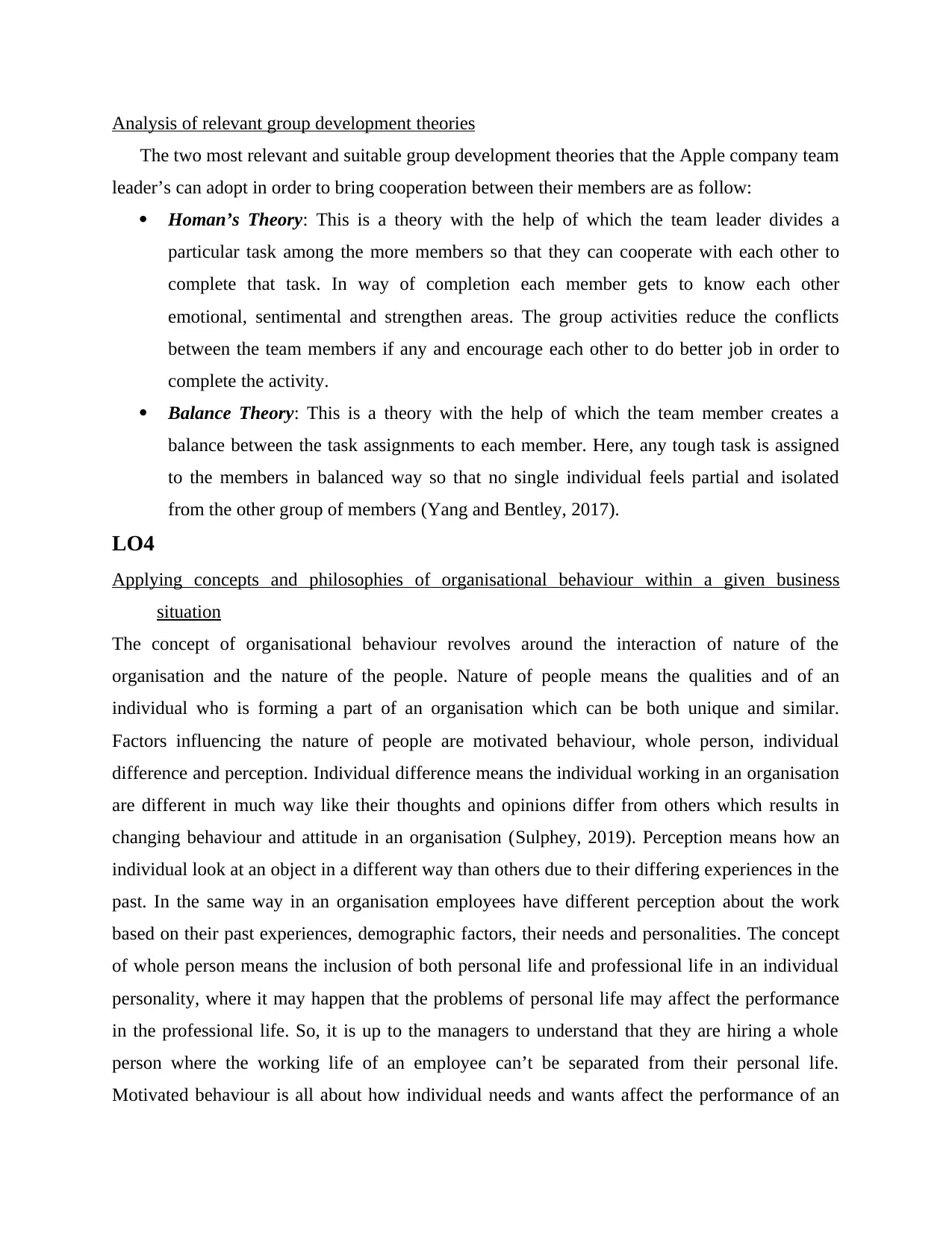
Analysis of relevant group development theories
The two most relevant and suitable group development theories that the Apple company team
leader’s can adopt in order to bring cooperation between their members are as follow:
Homan’s Theory: This is a theory with the help of which the team leader divides a
particular task among the more members so that they can cooperate with each other to
complete that task. In way of completion each member gets to know each other
emotional, sentimental and strengthen areas. The group activities reduce the conflicts
between the team members if any and encourage each other to do better job in order to
complete the activity.
Balance Theory: This is a theory with the help of which the team member creates a
balance between the task assignments to each member. Here, any tough task is assigned
to the members in balanced way so that no single individual feels partial and isolated
from the other group of members (Yang and Bentley, 2017).
LO4
Applying concepts and philosophies of organisational behaviour within a given business
situation
The concept of organisational behaviour revolves around the interaction of nature of the
organisation and the nature of the people. Nature of people means the qualities and of an
individual who is forming a part of an organisation which can be both unique and similar.
Factors influencing the nature of people are motivated behaviour, whole person, individual
difference and perception. Individual difference means the individual working in an organisation
are different in much way like their thoughts and opinions differ from others which results in
changing behaviour and attitude in an organisation (Sulphey, 2019). Perception means how an
individual look at an object in a different way than others due to their differing experiences in the
past. In the same way in an organisation employees have different perception about the work
based on their past experiences, demographic factors, their needs and personalities. The concept
of whole person means the inclusion of both personal life and professional life in an individual
personality, where it may happen that the problems of personal life may affect the performance
in the professional life. So, it is up to the managers to understand that they are hiring a whole
person where the working life of an employee can’t be separated from their personal life.
Motivated behaviour is all about how individual needs and wants affect the performance of an
The two most relevant and suitable group development theories that the Apple company team
leader’s can adopt in order to bring cooperation between their members are as follow:
Homan’s Theory: This is a theory with the help of which the team leader divides a
particular task among the more members so that they can cooperate with each other to
complete that task. In way of completion each member gets to know each other
emotional, sentimental and strengthen areas. The group activities reduce the conflicts
between the team members if any and encourage each other to do better job in order to
complete the activity.
Balance Theory: This is a theory with the help of which the team member creates a
balance between the task assignments to each member. Here, any tough task is assigned
to the members in balanced way so that no single individual feels partial and isolated
from the other group of members (Yang and Bentley, 2017).
LO4
Applying concepts and philosophies of organisational behaviour within a given business
situation
The concept of organisational behaviour revolves around the interaction of nature of the
organisation and the nature of the people. Nature of people means the qualities and of an
individual who is forming a part of an organisation which can be both unique and similar.
Factors influencing the nature of people are motivated behaviour, whole person, individual
difference and perception. Individual difference means the individual working in an organisation
are different in much way like their thoughts and opinions differ from others which results in
changing behaviour and attitude in an organisation (Sulphey, 2019). Perception means how an
individual look at an object in a different way than others due to their differing experiences in the
past. In the same way in an organisation employees have different perception about the work
based on their past experiences, demographic factors, their needs and personalities. The concept
of whole person means the inclusion of both personal life and professional life in an individual
personality, where it may happen that the problems of personal life may affect the performance
in the professional life. So, it is up to the managers to understand that they are hiring a whole
person where the working life of an employee can’t be separated from their personal life.
Motivated behaviour is all about how individual needs and wants affect the performance of an
⊘ This is a preview!⊘
Do you want full access?
Subscribe today to unlock all pages.

Trusted by 1+ million students worldwide
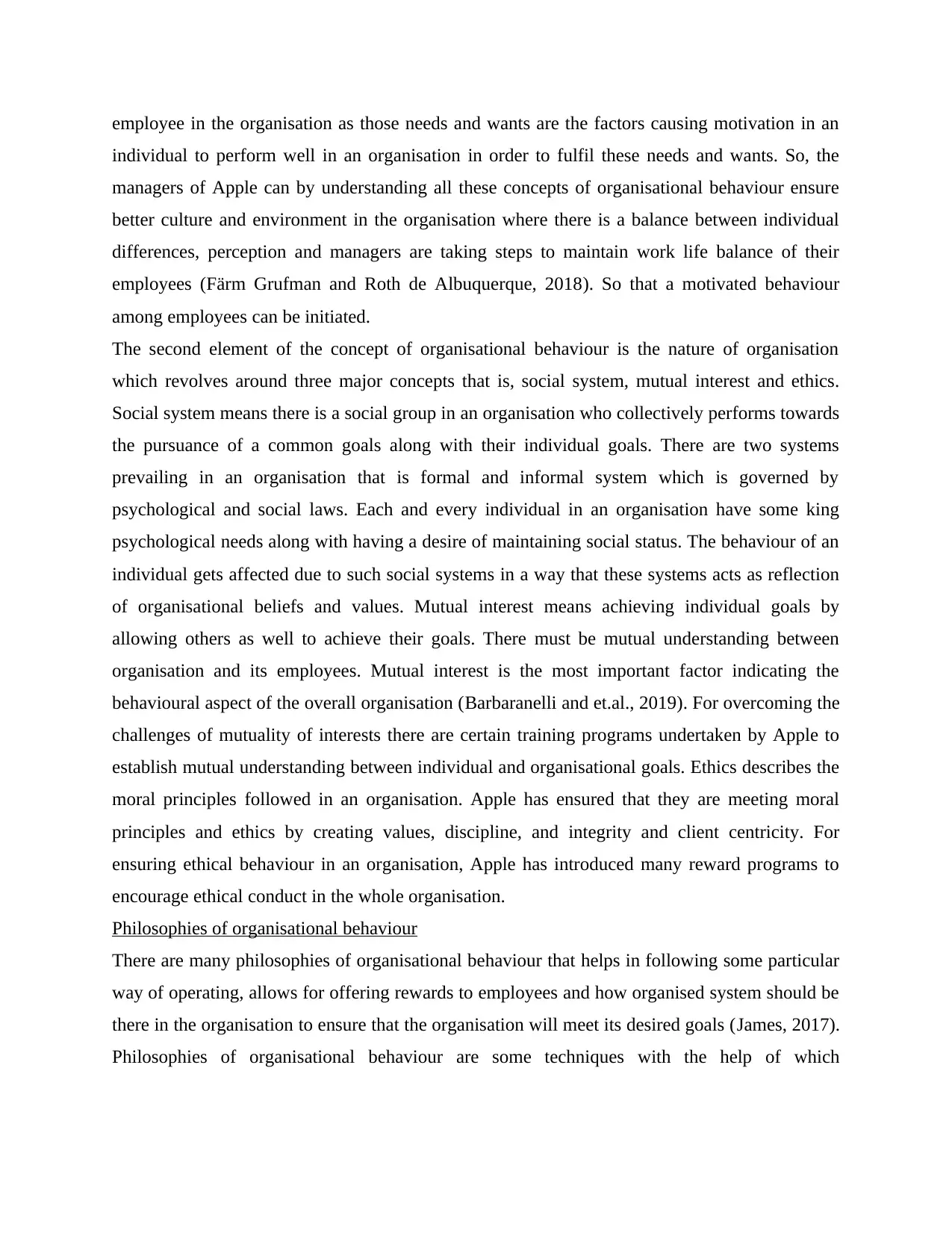
employee in the organisation as those needs and wants are the factors causing motivation in an
individual to perform well in an organisation in order to fulfil these needs and wants. So, the
managers of Apple can by understanding all these concepts of organisational behaviour ensure
better culture and environment in the organisation where there is a balance between individual
differences, perception and managers are taking steps to maintain work life balance of their
employees (Färm Grufman and Roth de Albuquerque, 2018). So that a motivated behaviour
among employees can be initiated.
The second element of the concept of organisational behaviour is the nature of organisation
which revolves around three major concepts that is, social system, mutual interest and ethics.
Social system means there is a social group in an organisation who collectively performs towards
the pursuance of a common goals along with their individual goals. There are two systems
prevailing in an organisation that is formal and informal system which is governed by
psychological and social laws. Each and every individual in an organisation have some king
psychological needs along with having a desire of maintaining social status. The behaviour of an
individual gets affected due to such social systems in a way that these systems acts as reflection
of organisational beliefs and values. Mutual interest means achieving individual goals by
allowing others as well to achieve their goals. There must be mutual understanding between
organisation and its employees. Mutual interest is the most important factor indicating the
behavioural aspect of the overall organisation (Barbaranelli and et.al., 2019). For overcoming the
challenges of mutuality of interests there are certain training programs undertaken by Apple to
establish mutual understanding between individual and organisational goals. Ethics describes the
moral principles followed in an organisation. Apple has ensured that they are meeting moral
principles and ethics by creating values, discipline, and integrity and client centricity. For
ensuring ethical behaviour in an organisation, Apple has introduced many reward programs to
encourage ethical conduct in the whole organisation.
Philosophies of organisational behaviour
There are many philosophies of organisational behaviour that helps in following some particular
way of operating, allows for offering rewards to employees and how organised system should be
there in the organisation to ensure that the organisation will meet its desired goals (James, 2017).
Philosophies of organisational behaviour are some techniques with the help of which
individual to perform well in an organisation in order to fulfil these needs and wants. So, the
managers of Apple can by understanding all these concepts of organisational behaviour ensure
better culture and environment in the organisation where there is a balance between individual
differences, perception and managers are taking steps to maintain work life balance of their
employees (Färm Grufman and Roth de Albuquerque, 2018). So that a motivated behaviour
among employees can be initiated.
The second element of the concept of organisational behaviour is the nature of organisation
which revolves around three major concepts that is, social system, mutual interest and ethics.
Social system means there is a social group in an organisation who collectively performs towards
the pursuance of a common goals along with their individual goals. There are two systems
prevailing in an organisation that is formal and informal system which is governed by
psychological and social laws. Each and every individual in an organisation have some king
psychological needs along with having a desire of maintaining social status. The behaviour of an
individual gets affected due to such social systems in a way that these systems acts as reflection
of organisational beliefs and values. Mutual interest means achieving individual goals by
allowing others as well to achieve their goals. There must be mutual understanding between
organisation and its employees. Mutual interest is the most important factor indicating the
behavioural aspect of the overall organisation (Barbaranelli and et.al., 2019). For overcoming the
challenges of mutuality of interests there are certain training programs undertaken by Apple to
establish mutual understanding between individual and organisational goals. Ethics describes the
moral principles followed in an organisation. Apple has ensured that they are meeting moral
principles and ethics by creating values, discipline, and integrity and client centricity. For
ensuring ethical behaviour in an organisation, Apple has introduced many reward programs to
encourage ethical conduct in the whole organisation.
Philosophies of organisational behaviour
There are many philosophies of organisational behaviour that helps in following some particular
way of operating, allows for offering rewards to employees and how organised system should be
there in the organisation to ensure that the organisation will meet its desired goals (James, 2017).
Philosophies of organisational behaviour are some techniques with the help of which
Paraphrase This Document
Need a fresh take? Get an instant paraphrase of this document with our AI Paraphraser
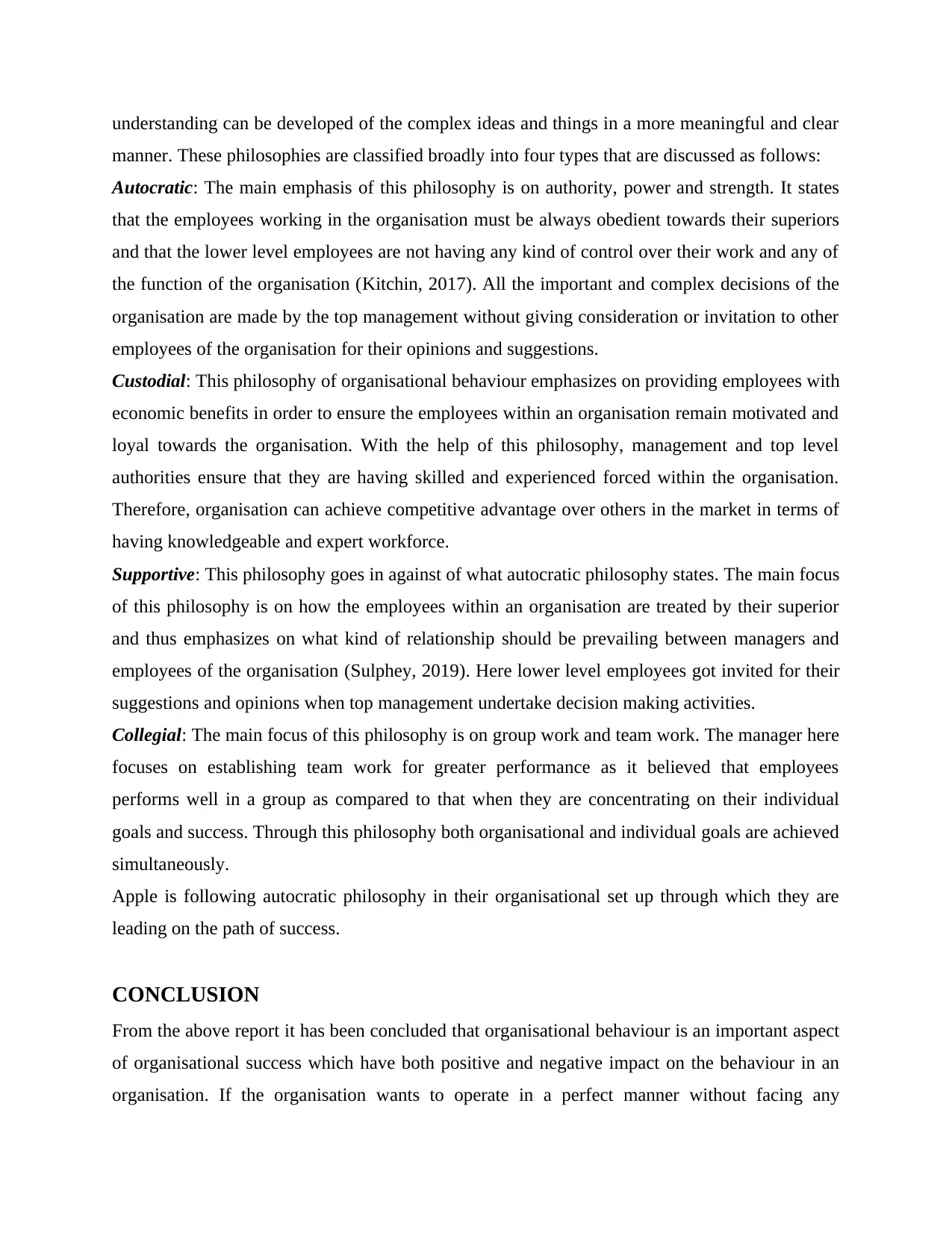
understanding can be developed of the complex ideas and things in a more meaningful and clear
manner. These philosophies are classified broadly into four types that are discussed as follows:
Autocratic: The main emphasis of this philosophy is on authority, power and strength. It states
that the employees working in the organisation must be always obedient towards their superiors
and that the lower level employees are not having any kind of control over their work and any of
the function of the organisation (Kitchin, 2017). All the important and complex decisions of the
organisation are made by the top management without giving consideration or invitation to other
employees of the organisation for their opinions and suggestions.
Custodial: This philosophy of organisational behaviour emphasizes on providing employees with
economic benefits in order to ensure the employees within an organisation remain motivated and
loyal towards the organisation. With the help of this philosophy, management and top level
authorities ensure that they are having skilled and experienced forced within the organisation.
Therefore, organisation can achieve competitive advantage over others in the market in terms of
having knowledgeable and expert workforce.
Supportive: This philosophy goes in against of what autocratic philosophy states. The main focus
of this philosophy is on how the employees within an organisation are treated by their superior
and thus emphasizes on what kind of relationship should be prevailing between managers and
employees of the organisation (Sulphey, 2019). Here lower level employees got invited for their
suggestions and opinions when top management undertake decision making activities.
Collegial: The main focus of this philosophy is on group work and team work. The manager here
focuses on establishing team work for greater performance as it believed that employees
performs well in a group as compared to that when they are concentrating on their individual
goals and success. Through this philosophy both organisational and individual goals are achieved
simultaneously.
Apple is following autocratic philosophy in their organisational set up through which they are
leading on the path of success.
CONCLUSION
From the above report it has been concluded that organisational behaviour is an important aspect
of organisational success which have both positive and negative impact on the behaviour in an
organisation. If the organisation wants to operate in a perfect manner without facing any
manner. These philosophies are classified broadly into four types that are discussed as follows:
Autocratic: The main emphasis of this philosophy is on authority, power and strength. It states
that the employees working in the organisation must be always obedient towards their superiors
and that the lower level employees are not having any kind of control over their work and any of
the function of the organisation (Kitchin, 2017). All the important and complex decisions of the
organisation are made by the top management without giving consideration or invitation to other
employees of the organisation for their opinions and suggestions.
Custodial: This philosophy of organisational behaviour emphasizes on providing employees with
economic benefits in order to ensure the employees within an organisation remain motivated and
loyal towards the organisation. With the help of this philosophy, management and top level
authorities ensure that they are having skilled and experienced forced within the organisation.
Therefore, organisation can achieve competitive advantage over others in the market in terms of
having knowledgeable and expert workforce.
Supportive: This philosophy goes in against of what autocratic philosophy states. The main focus
of this philosophy is on how the employees within an organisation are treated by their superior
and thus emphasizes on what kind of relationship should be prevailing between managers and
employees of the organisation (Sulphey, 2019). Here lower level employees got invited for their
suggestions and opinions when top management undertake decision making activities.
Collegial: The main focus of this philosophy is on group work and team work. The manager here
focuses on establishing team work for greater performance as it believed that employees
performs well in a group as compared to that when they are concentrating on their individual
goals and success. Through this philosophy both organisational and individual goals are achieved
simultaneously.
Apple is following autocratic philosophy in their organisational set up through which they are
leading on the path of success.
CONCLUSION
From the above report it has been concluded that organisational behaviour is an important aspect
of organisational success which have both positive and negative impact on the behaviour in an
organisation. If the organisation wants to operate in a perfect manner without facing any
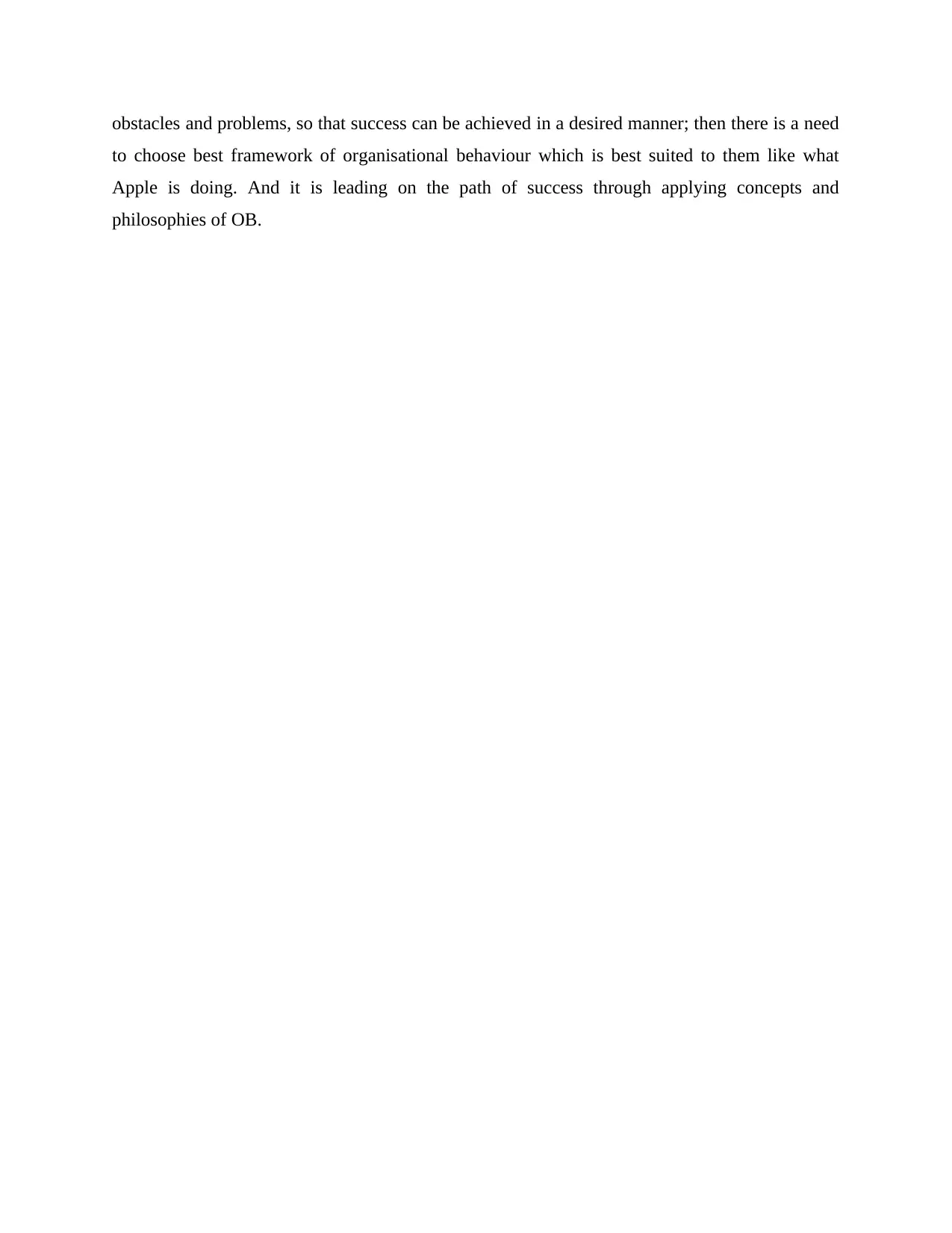
obstacles and problems, so that success can be achieved in a desired manner; then there is a need
to choose best framework of organisational behaviour which is best suited to them like what
Apple is doing. And it is leading on the path of success through applying concepts and
philosophies of OB.
to choose best framework of organisational behaviour which is best suited to them like what
Apple is doing. And it is leading on the path of success through applying concepts and
philosophies of OB.
⊘ This is a preview!⊘
Do you want full access?
Subscribe today to unlock all pages.

Trusted by 1+ million students worldwide
1 out of 14
Related Documents
Your All-in-One AI-Powered Toolkit for Academic Success.
+13062052269
info@desklib.com
Available 24*7 on WhatsApp / Email
![[object Object]](/_next/static/media/star-bottom.7253800d.svg)
Unlock your academic potential
Copyright © 2020–2025 A2Z Services. All Rights Reserved. Developed and managed by ZUCOL.





